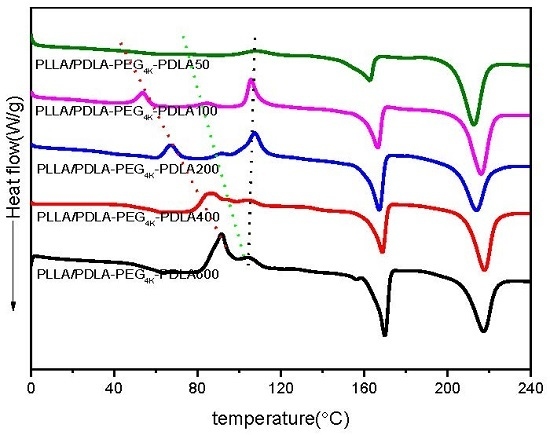Competitive Stereocomplexation and Homocrystallization Behaviors in the Poly(lactide) Blends of PLLA and PDLA-PEG-PDLA with Controlled Block Length
Abstract
:1. Introduction
2. Experimental Section
2.1. Materials and Reagents
2.2. Synthesis and Characterization of PDLA-PEG-PDLA
2.3. Preparation of PLLA/PDLA-PEG-PDLA Blends
2.4. Measurement of Blends
3. Results and Discussion
3.1. Effect of L/D Ratios on Stereocomplexation of PLLA/PDLA-PEG-PDLA Blends
3.2. Effect of PEG Block on Stereocomplexation of PLLA/PDLA-PEG-PDLA Blends
3.3. Effect of PDLA Block on Stereocomplexation of PLLA/PDLA-PEG-PDLA Blends
4. Conclusions
Supplementary Materials
Acknowledgments
Author Contributions
Conflicts of Interest
References
- Nampoothiri, K.M.; Nair, N.R.; John, R.P. An overview of the recent developments in polylactide (PLA) research. Bioresour. Technol. 2010, 101, 8493–8501. [Google Scholar] [CrossRef] [PubMed]
- Rasal, R.M.; Janorkar, A.V.; Hirt, D.E. Poly(lactic acid) modifications. Prog. Polym. Sci. 2010, 35, 338–356. [Google Scholar] [CrossRef]
- Li, J.Z.; Schultz, J.M.; Chan, C.M. The relationship between morphology and impact toughness of poly(l-lactic acid)/poly(ethylene oxide) blends. Polymer 2015, 63, 179–188. [Google Scholar] [CrossRef]
- Ikada, Y.; Tsuji, H. Biodegradable polyesters for medical and ecological applications. Macromol. Rapid Commun. 2000, 21, 117–132. [Google Scholar] [CrossRef]
- Siracusa, V.; Rocculi, P.; Romani, S.; Rosa, M.D. Biodegradable polymers for food packaging: A review. Trends Food Sci. Technol. 2008, 19, 634–643. [Google Scholar] [CrossRef]
- Chiu, F.C.; Kan, C.Y.; Yang, J.C. The effects of melt annealing and counterpart’s molecular weight on the thermal properties and phase morphology of poly(l-lactide)-based blends. J. Polym. Sci. Pol. Phys. 2009, 47, 1497–1510. [Google Scholar] [CrossRef]
- Moon, S.I.; Jie, F.; Lee, C.; Tsutsumi, S.; Hyon, S. Novel carbon nanotube/poly(l-lactic acid) nanocomposites; their modulus, thermal stability, and electrical conductivity. Macromol. Symp. 2005, 224, 287–296. [Google Scholar] [CrossRef]
- Yokohara, T.; Yamaguchi, M. Structure and properties for biomass-based polyester blends of PLA and PBS. Eur. Polym. J. 2008, 44, 677–685. [Google Scholar] [CrossRef]
- Brutman, J.P.; Delgado, P.A.; Hillmyer, M.A. Polylactide vitrimers. ACS Macro Lett. 2014, 3, 607–610. [Google Scholar] [CrossRef]
- Michell, R.M.; Müller, A.J.; Spasova, M.; Dubois, P.; Burattini, S.; Greenland, B.W.; Hamley, I.W.; Hermida-Merino, D.; Cheval, N.; Fahmi, A. Crystallization and stereocomplexation behavior of poly (d- and l-lactide)-b-poly(N,N-dimethylamino-2-ethyl methacrylate) block copolymers. J. Polym. Sci. Polym. Phys. 2011, 49, 1397–1409. [Google Scholar] [CrossRef]
- Kakuta, M.; Hirata, M.; Kimura, Y. Stereoblock polylactides as high-Performance bio-Based polymers. J. Macromol. Sci. Part C Polym. Rev. 2009, 49, 107–140. [Google Scholar] [CrossRef]
- Woo, E.M.; Chang, L. Crystallization and morphology of stereocomplexes in nonequimolar mixtures of poly(l-lactic acid) with excess poly(d-lactic acid). Polymer 2011, 52, 6080–6089. [Google Scholar] [CrossRef]
- Tsuji, H.; Takai, H.; Saha, S.K. Isothermal and non-isothermal crystallization behavior of poly(l-lactic acid): Effects of stereocomplex as nucleating agent. Polymer 2006, 47, 3826–3837. [Google Scholar] [CrossRef]
- Zhang, J.; Sato, H.; Tsuji, H.; Noda, I.; Ozaki, Y. Differences in the CH3⋯O=C interactions among poly(l-lactide), poly(l-lactide)/poly(d-lactide) stereocomplex, and poly(3-hydroxybutyrate) studied by infrared spectroscopy. J. Mol. Struct. 2005, 735, 249–257. [Google Scholar] [CrossRef]
- Bai, H.; Liu, H.; Bai, D.; Zhang, Q.; Wang, K.; Deng, H.; Chen, F.; Fu, Q. Enhancing the melt stability of polylactide stereocomplexes using a solid-state cross-linking strategy during a melt-blending process. Polym. Chem. 2014, 5, 5985–5993. [Google Scholar] [CrossRef]
- Pan, P.; Han, L.; Bao, J.; Xie, Q.; Shan, G.; Bao, Y. Competitive stereocomplexation, homocrystallization, and polymorphic crystalline transition in poly(l-lactic acid)/poly(d-lactic acid) racemic blends: Molecular weight effects. J. Phys. Chem. B 2015, 119, 6462–6470. [Google Scholar] [CrossRef] [PubMed]
- Tsuji, H.; Matsumura, N.; Arakawa, Y. Stereocomplex crystallization and homocrystallization of star-shaped four-armed stereo diblock poly(lactide)s with different l-lactyl unit contents: Isothermal crystallization from the melt. J. Phys. Chem. B 2016, 120, 1183–1193. [Google Scholar] [CrossRef] [PubMed]
- Sarasua, J.R.; López-Rodríguez, N.; Arraiza, A.L.; Meaurio, E. Stereoselective crystallization and specific interactions in polylactides. Macromolecules 2005, 38, 8362–8371. [Google Scholar] [CrossRef]
- López-Rodríguez, N.; de Arenaza, I.M.; Meaurio, E.; Sarasua, J.R. Improvement of toughness by stereocomplex crystal formation in optically pure polylactides of high molecular weight. J. Mech. Behav. Biomed. Mater. 2014, 37, 219–225. [Google Scholar] [CrossRef] [PubMed]
- López-Rodríguez, N.; de Arenaza, I.M.; Meaurio, I.; Sarasua, J.R. Efficient stereocomplex crystallization in enantiomeric blends of high molecular weight polylactides. RSC Adv. 2015, 5, 34525–34534. [Google Scholar] [CrossRef]
- Arenaza, I.M.; Sarasua, J.R.; Amestoy, H.; Lopez-Rodriguez, N.; Zuza, E.; Meaurio, E.; Meyer, F.; Santos, J.I.; Raquez, J.M.; Dubois, P. Polylactide stereocomplex crystallization prompted by multiwall carbon nanotubes. J. Appl. Polym. Sci. 2013, 130, 4327–4337. [Google Scholar] [CrossRef]
- Cui, L.; Wang, Y.; Guo, Y.; Liu, Y.; Chao, J.; Zhang, C.; Zhu, P. Cooperative effects of nucleation agent and plasticizer on crystallization properties of stereocomplex-type poly(lactide acid). Polym. Adv. Technol. 2016, 27, 1301–1307. [Google Scholar] [CrossRef]
- Hirata, M.; Masutani, K.; Kimura, Y. Synthesis of ABCBA penta stereoblock polylactide copolymers by two-step ring-opening polymerization of l- and d-lactides with poly(3-methyl-1,5-pentylene succinate) as macroinitiator (C): Development of flexible stereocomplexed polylactide materials. Biomacromolecules 2013, 14, 2154–2161. [Google Scholar] [CrossRef] [PubMed]
- Song, Y.; Wang, D.; Jiang, N.; Gan, Z. Role of PEG segment in stereocomplex crystallization for PLLA/PDLA-b-PEG-b-PDLA blends. ACS Sustain. Chem. Eng. 2015, 3, 1492–1500. [Google Scholar] [CrossRef]
- Jing, Z.; Shi, X.; Zhang, G.; Lei, R. Investigation of poly(lactide) stereocomplexation between linear poly(l-lactide) and PDLA-PEG-PDLA tri-block copolymer. Polym. Int. 2015, 64, 1399–1407. [Google Scholar] [CrossRef]
- Purnama, P.; Jung, Y.; Kim, S.H. Stereocomplexation of poly(l-lactide) and random copolymer poly(d-lactide-co-ε-caprolactone) to enhance melt stability. Macromolecules 2012, 45, 4012–4014. [Google Scholar] [CrossRef]
- Liu, Y.; Shao, J.; Sun, J.; Bian, X.; Feng, L.; Xiang, S.; Sun, B.; Chen, Z.; Li, G.; Chen, X. Improved mechanical and thermal properties of PLLA by solvent blending with PDLA-b-PEG-b-PDLA. Polym. Degrad. Stab. 2014, 101, 10–17. [Google Scholar] [CrossRef]
- Nijenhuis, A.J.; Colstee, E.; Grijpma, D.W.; Pennings, A.J. High molecular weight poly(l-lactide) and poly(ethylene oxide) blends: Thermal characterization and physical properties. Polymer 1996, 37, 5849–5857. [Google Scholar] [CrossRef]
- Kim, K.S.; Chin, I.J.; Yoon, J.S.; Choi, H.J.; Lee, D.C.; Lee, K.H. Crystallization behavior and mechanical properties of poly(ethylene oxide)/poly(l-lactide)/poly(vinyl acetate) blends. J. Appl. Polym. Sci. 2001, 82, 3618–3626. [Google Scholar] [CrossRef]
- Abebe, D.G.; Fujiwara, T. Controlled thermoresponsive hydrogels by stereocomplexed PLA-PEG-PLA prepared via hybrid micelles of pre-mixed copolymers with different PEG lengths. Biomacromolecules 2012, 13, 1828–1836. [Google Scholar] [CrossRef] [PubMed]
- Fujiwara, T.; Mukose, T.; Yamaoka, T.; Yamane, H.; Sakurai, S.; Kimura, Y. Novel thermo-responsive formation of a hydrogel by stereo-complexation between PLLA-PEG-PLLA and PDLA-PEG-PDLA block copolymers. Macromol. Biosci. 2001, 1, 204–208. [Google Scholar] [CrossRef]
- Rathi, S.R.; Coughlin, E.B.; Hsu, S.L.; Golub, C.S.; Ling, G.H. Effect of midblock on the morphology and properties of blends of ABA triblock copolymers of PDLA-mid-block-PDLA with PLLA. Polymer 2012, 53, 3008–3016. [Google Scholar] [CrossRef]
- Rathi, S.; Chen, X.; Coughlin, E.B.; Hsu, S.L.; Golub, C.S.; Tzivanis, M.J. Toughening semicrystalline poly(lactic acid) by morphology alteration. Polymer 2011, 52, 4184–4188. [Google Scholar] [CrossRef]
- Jing, Z.; Shi, X.; Zhang, G.; Li, J. Rheology and crystallization behavior of PLLA/TiO2-g-PDLA composites. Polym. Adv. Technol. 2015, 26, 528–537. [Google Scholar] [CrossRef]
- Pan, P.; Yang, J.; Shan, G.; Bao, Y.; Weng, Z.; Cao, A.; Yazawa, K.; Inoue, Y. Temperature-variable FTIR and solid-state 13C NMR investigations on crystalline structure and molecular dynamics of polymorphic poly(l-lactide) and poly(l-lactide)/poly(d-lactide) stereocomplex. Macromolecules 2011, 45, 189–197. [Google Scholar] [CrossRef]
- Shao, J.; Sun, J.; Bian, X.; Cui, Y.; Li, G.; Chen, X. Investigation of poly(lactide) stereocomplexes: 3-armed poly (l-lactide) blended with linear and 3-armed enantiomers. J. Phys. Chem. B 2012, 116, 9983–9991. [Google Scholar] [CrossRef] [PubMed]
- Han, L.; Shan, G.; Bao, Y.; Pan, P. Exclusive stereocomplex crystallization of linear and multiarm star-shaped high-molecular-weight stereo diblock poly(lactic acid)s. J. Phys. Chem. B 2015, 119, 14270–14279. [Google Scholar] [CrossRef] [PubMed]
- Xu, H.; Teng, C.; Yu, M. Improvements of thermal property and crystallization behavior of PLLA based multiblock copolymer by forming stereocomplex with PDLA oligomer. Polymer 2006, 47, 3922–3928. [Google Scholar] [CrossRef]
- Wei, X.F.; Bao, R.Y.; Cao, Z.Q.; Yang, W.; Xie, B.H.; Yang, M.B. Stereocomplex crystallite network in asymmetric PLLA/PDLA blends: Formation, structure, and confining effect on the crystallization rate of homocrystallites. Macromolecules 2014, 47, 1439–1448. [Google Scholar] [CrossRef]
- Ma, P.; Shen, T.; Xu, P.; Dong, W.; Lemstra, P.J.; Chen, M. Superior performance of fully biobased poly(lactide) via stereocomplexation-induced phase separation: Structure versus property. ACS Sustain. Chem. Eng. 2015, 3, 1470–1478. [Google Scholar] [CrossRef]
- Xu, Y.; Wang, Y.; Xu, T.; Zhang, J.; Liu, C. Crystallization kinetics and morphology of partially melted poly (lactic acid). Polym. Test. 2014, 37, 179–185. [Google Scholar] [CrossRef]
- Tsuji, H.; Miyase, T.; Tezuka, Y.; Saha, S.K. Physical properties, crystallization, and spherulite growth of linear and 3-arm poly(l-lactide)s. Biomacromolecules 2005, 6, 244–254. [Google Scholar] [CrossRef] [PubMed]
- Chang, L.; Woo, E.M. Effects of molten poly(3-hydroxybutyrate) on crystalline morphology in stereocomplex of poly(l-lactic acid) with poly(d-lactic acid). Polymer 2011, 52, 68–76. [Google Scholar] [CrossRef]
- Saeidlou, S.; Huneault, M.A.; Li, H.; Park, C.B. Poly(lactic acid) crystallization. Prog. Polym. Sci. 2012, 37, 1657–1677. [Google Scholar] [CrossRef]
- Bouapao, L.; Tsuji, H. Stereocomplex crystallization and spherulite growth of low molecular weight poly(l-lactide) and poly(d-lactide) from the melt. Macromol. Chem. Phys. 2009, 210, 993–1002. [Google Scholar] [CrossRef]
- Shao, J.; Guo, Y.; Xiang, S.; Zhou, D.; Bian, X.; Sun, J.; Li, G.; Hou, H. The morphology and spherulite growth of PLA stereocomplex in linear and branched PLLA/PDLA blends: Effects of molecular weight and structure. CrystEngComm 2016, 18, 274–282. [Google Scholar] [CrossRef]
- Feldstein, M.M.; Shandryuk, G.A.; Kuptsov, S.A.; Platé, N.A. Coherence of thermal transitions in poly(N-vinyl pyrrolidone)–poly(ethylene glycol) compatible blends 1. Interrelations among the temperatures of melting, maximum cold crystallization rate and glass transition. Polymer 2001, 42, 981–990. [Google Scholar] [CrossRef]
- Wang, L.; Jing, X.; Cheng, H.; Hu, X.; Yang, L.; Huang, Y. Rheology and crystallization of long-chain branched poly(l-lactide)s with controlled branch length. Ind. Eng. Chem. Res. 2012, 51, 10731–10741. [Google Scholar] [CrossRef]
- Pei, A.; Zhou, Q.; Berglund, L.A. Functionalized cellulose nanocrystals as biobased nucleation agents in poly(l-lactide)(PLLA)–crystallization and mechanical property effects. Compos. Sci. Technol. 2010, 70, 815–821. [Google Scholar] [CrossRef]
- Li, B.; Yu, J.; Lee, S.; Ree, M. Crystallizations of poly(ethylene terephthalate-co-ethylene isophthalate). Polymer 1999, 40, 5371–5375. [Google Scholar] [CrossRef]

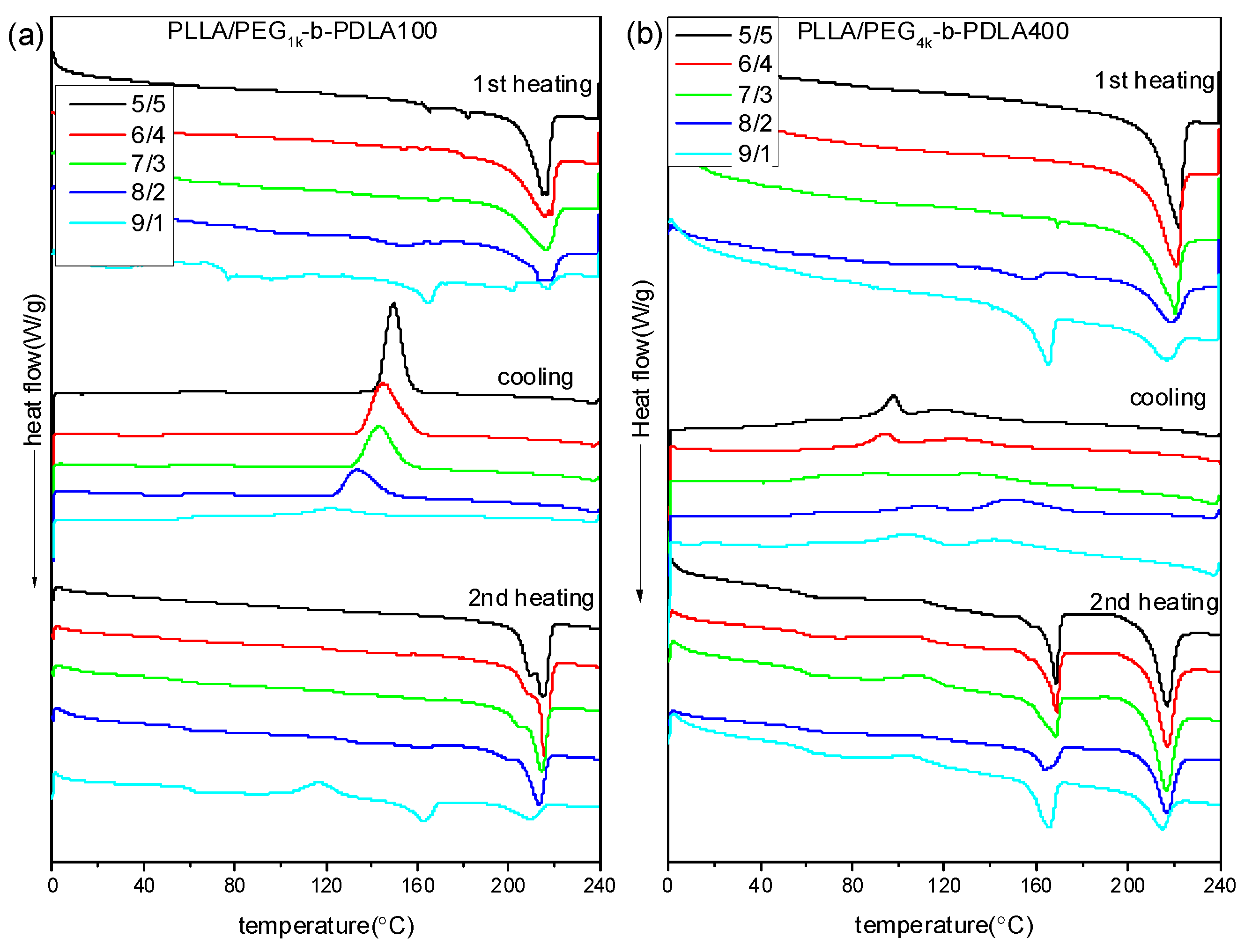
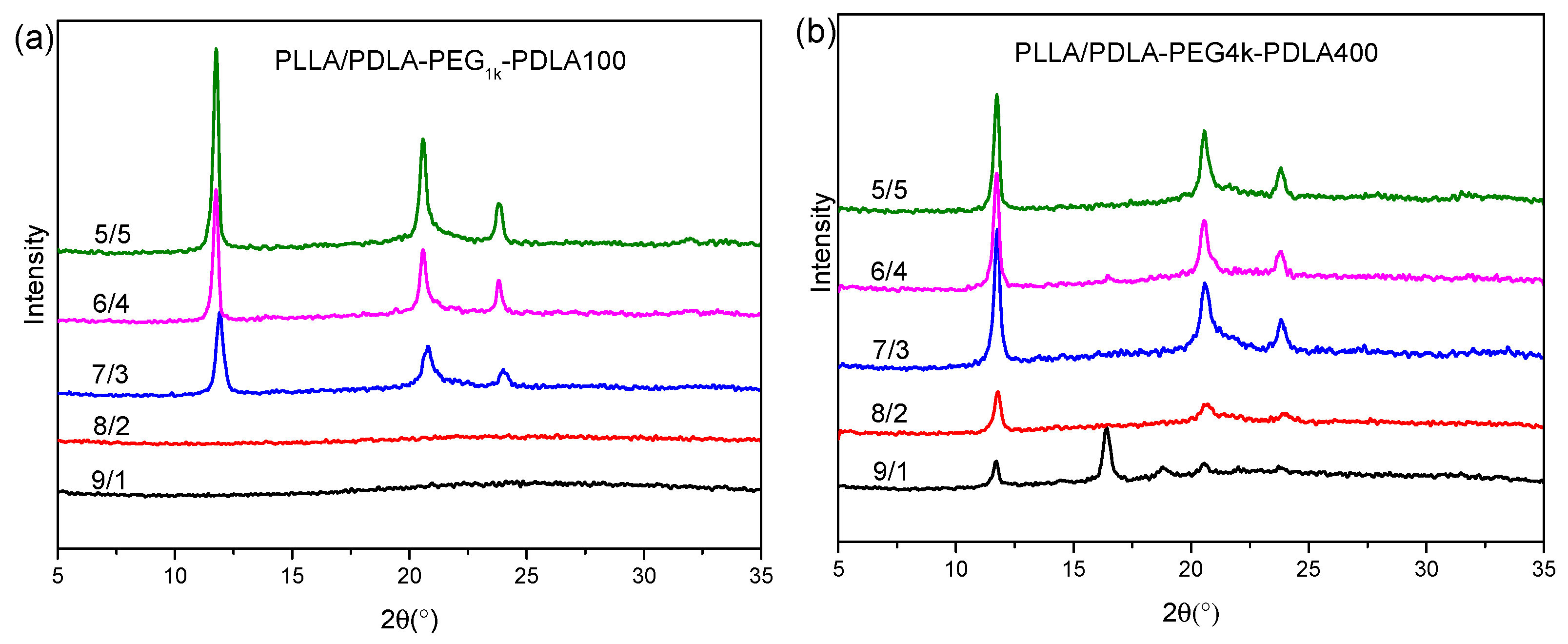


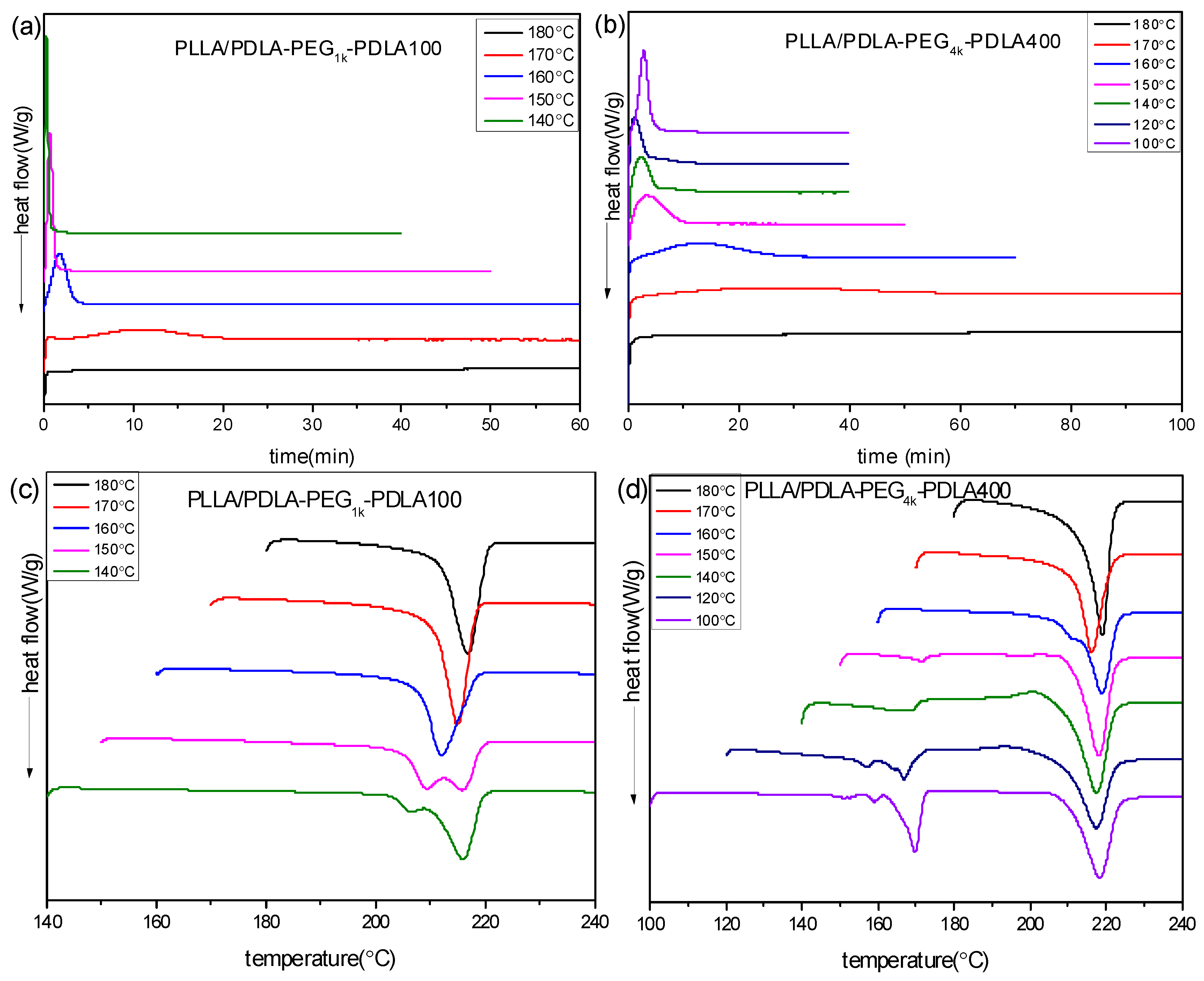
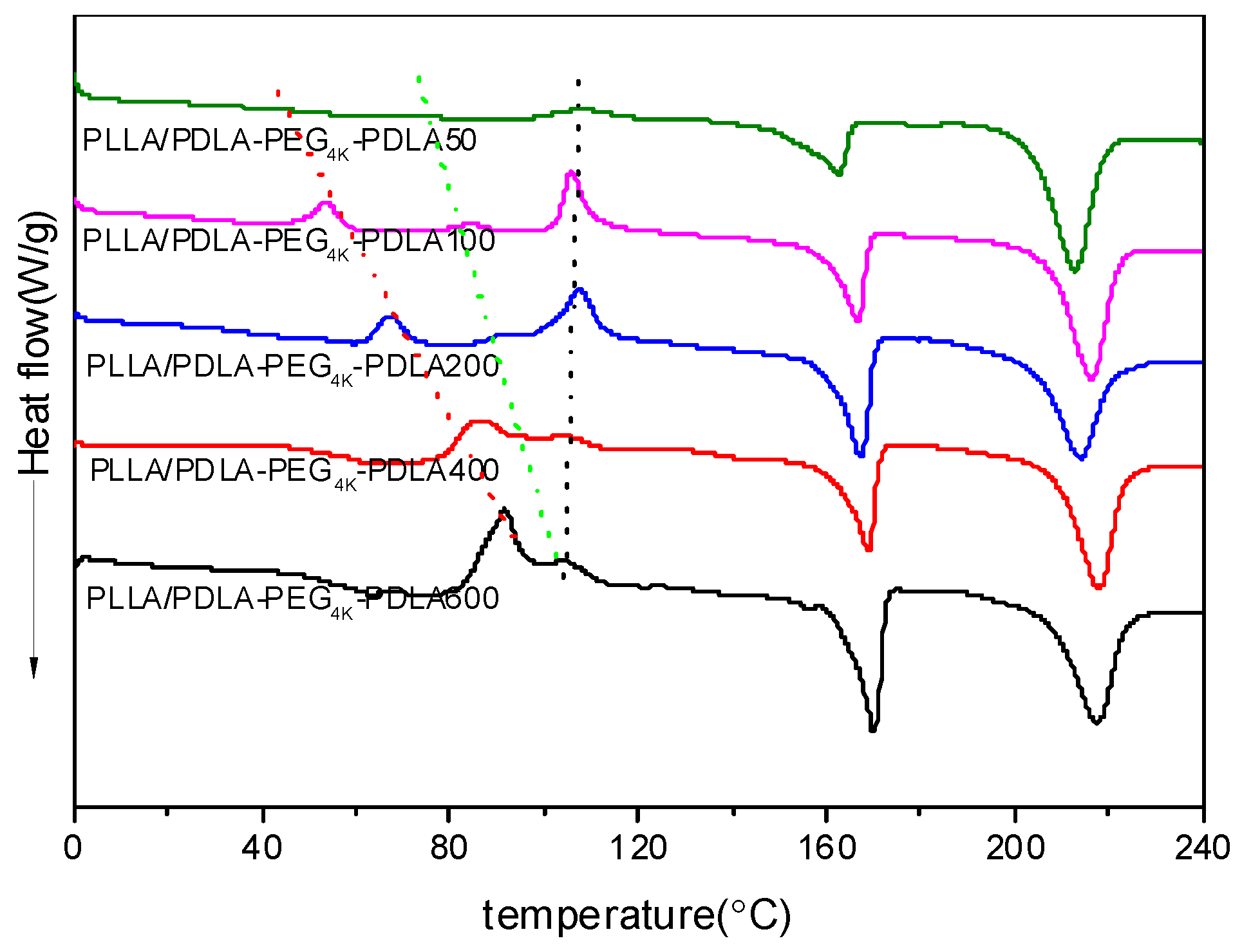
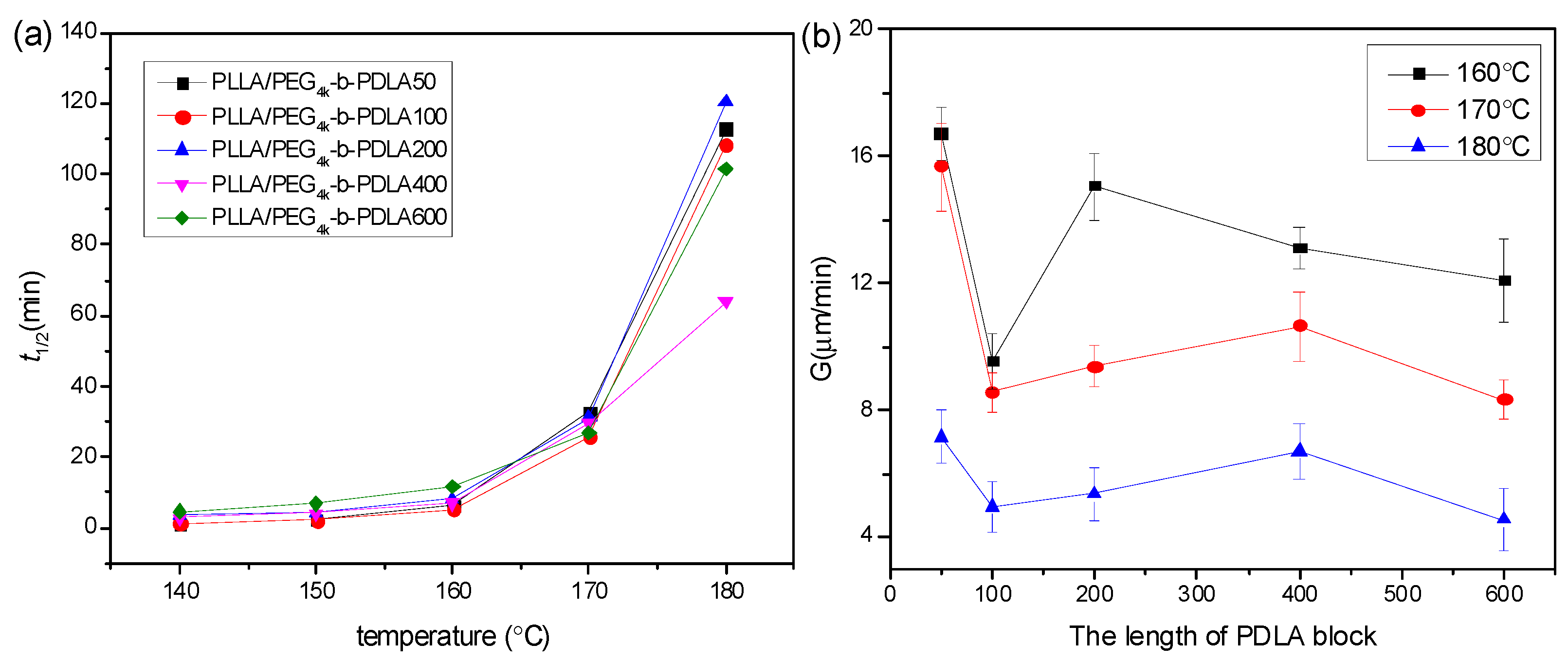

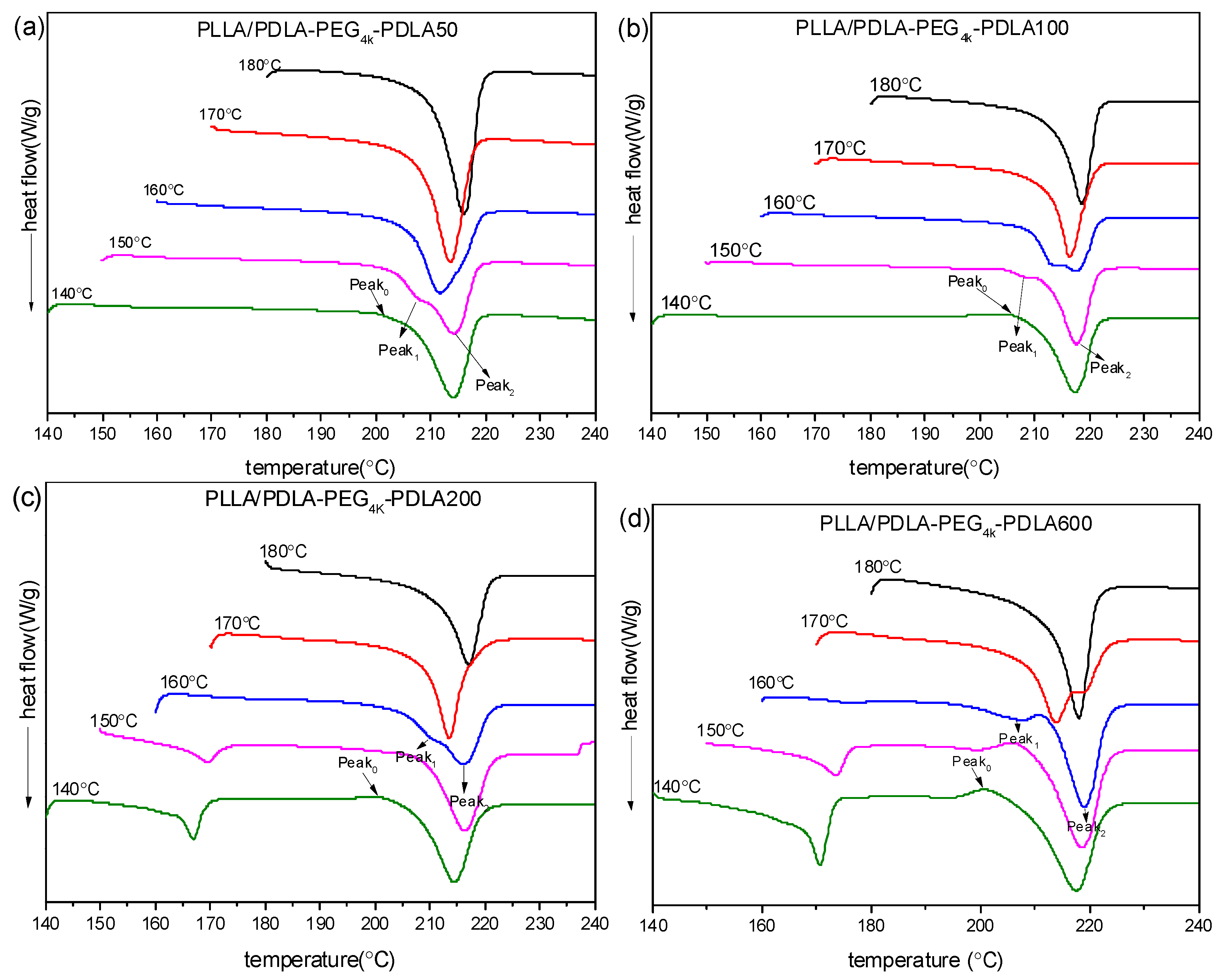
| Code | Mthe a (×104 g/moL) | Mn b (×104 g/moL) | Mn c (×104 g/moL) | PDI c | Tc d (°C) | Tm d (°C) | Yield (wt %) |
|---|---|---|---|---|---|---|---|
| PDLA-PEG4k-PDLA50 | 1.12 | 1.48 | 1.40 | 1.56 | 108 | 165 | 73.0 |
| PDLA-PEG4k-PDLA100 | 1.84 | 2.36 | 1.78 | 1.50 | 107 | 167 | 90.6 |
| PDLA-PEG4k-PDLA200 | 3.28 | 2.93 | 2.11 | 1.61 | 105 | 169 | 67.4 |
| PDLA-PEG4k-PDLA400 | 6.16 | 7.23 | 2.59 | 1.65 | 106 | 170 | 76.9 |
| PDLA-PEG4k-PDLA600 | 9.04 | 9.62 | 3.41 | 1.51 | 106 | 172 | 57.4 |
| PDLA-PEG0.4k-PLA100 | 1.48 | 2.07 | 1.47 | 1.40 | 102 | 170 | 93.4 |
| PDLA-PEG1k-PDLA100 | 1.54 | 2.51 | 1.43 | 1.63 | 112 | 161 | 55.8 |
| PDLA-PEG2k-PDLA100 | 1.64 | 2.91 | 1.57 | 1.57 | 105 | 171 | 92.4 |
| PDLA-PEG6k-PDLA100 | 2.04 | 2.52 | 1.96 | 1.72 | 111 | 168 | 68.6 |
| PDLA-PEG0.4k-PDLA400 | 5.80 | 6.20 | 2.53 | 1.71 | 105 | 172 | 86.0 |
| PDLA-PEG1k-PDLA400 | 5.86 | 7.86 | 2.43 | 1.52 | 110 | 171 | 89.2 |
| PDLA-PEG2k-PDLA400 | 5.96 | 7.10 | 2.34 | 1.47 | 109 | 170 | 88.2 |
| PDLA-PEG6k-PDLA400 | 6.16 | 9.71 | 2.52 | 1.61 | 110 | 173 | 55.4 |
| PEGX | PLLA/PDLA-PEGX-PDLA100 | PLLA/PDLA-PEGX-PDLA400 | ||||||
|---|---|---|---|---|---|---|---|---|
| n | k (min−n) | t1/2 (min) | G (um/min) | n | k (min−n) | t1/2 (min) | G (um/min) | |
| 0.4k | 2.50 | 4.26 × 10−3 | 7.83 | 5.00 | 3.65 | 1.29 × 10−3 | 7.64 | 7.85 |
| 1k | 2.61 | 4.83 × 10−4 | 1.76 | 9.98 | 2.49 | 1.03 × 10−3 | 6.17 | 7.73 |
| 2k | 2.80 | 1.81 × 10−3 | 8.37 | 8.57 | 3.15 | 1.43 × 10−3 | 7.22 | 16.10 |
| 4k | 3.13 | 2.39 × 10−3 | 5.36 | 5.36 | 2.08 | 1.56 × 10−2 | 13.77 | 8.93 |
| 6k | 2.81 | 3.79 × 10−3 | 7.69 | 5.00 | 3.09 | 1.34 × 10−3 | 5.66 | 8.34 |
© 2017 by the authors. Licensee MDPI, Basel, Switzerland. This article is an open access article distributed under the terms and conditions of the Creative Commons Attribution (CC BY) license ( http://creativecommons.org/licenses/by/4.0/).
Share and Cite
Jing, Z.; Shi, X.; Zhang, G. Competitive Stereocomplexation and Homocrystallization Behaviors in the Poly(lactide) Blends of PLLA and PDLA-PEG-PDLA with Controlled Block Length. Polymers 2017, 9, 107. https://doi.org/10.3390/polym9030107
Jing Z, Shi X, Zhang G. Competitive Stereocomplexation and Homocrystallization Behaviors in the Poly(lactide) Blends of PLLA and PDLA-PEG-PDLA with Controlled Block Length. Polymers. 2017; 9(3):107. https://doi.org/10.3390/polym9030107
Chicago/Turabian StyleJing, Zhanxin, Xuetao Shi, and Guangcheng Zhang. 2017. "Competitive Stereocomplexation and Homocrystallization Behaviors in the Poly(lactide) Blends of PLLA and PDLA-PEG-PDLA with Controlled Block Length" Polymers 9, no. 3: 107. https://doi.org/10.3390/polym9030107





